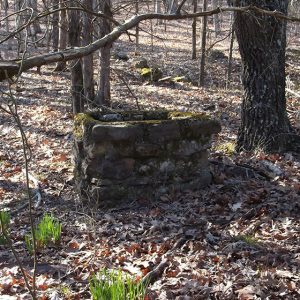calsfoundation@cals.org
Hazel Grove (Independence County)
The historic community of Hazel Grove is in Dota Township on Walden Road about four miles north-northeast of Cord (Independence County). It was once located on a main thoroughfare built in the early 1830s, the Military Road, which paralleled the Southwest Trail. Curia Creek is nearby, and the Black River lies a few miles to the east. Batesville, the county seat, is sixteen miles to the west-southwest. Hazel Grove is just south of the point at which Independence, Lawrence, and Sharp counties meet.
The French LaBass family played a leading role in establishing Hazel Grove. The deed records at Powhatan (Lawrence County) show that five French settlers claimed lands along the Black River: Joseph Janis, son of Anthony Janis; John Fayas (also LaBass), son-in-law of Anthony Janis; Cola LaCombe; Jerome Mattis; and Auguste Privet. Claims were settled in 1815, and the French settlers made deeds to a land speculator from St. Louis, Missouri, named William Russell.
John LaBass died in 1839 near Hazel Grove. One of his sons, John William LaBass, was born about 1811. It is believed that John William LaBass’s maternal grandmother was an Arikara Native American who married a French trapper and fur trader. John William LaBass served with Captain Jesse Bean and the Arkansas Mounted Rangers in 1832 at Fort Gibson in Indian Territory (present-day Oklahoma). Authors Washington Irving and Charles Latrobe accompanied the Rangers. Bean’s father, Robert, was an early settler in Batesville. LaBass was given 120 acres in Lawrence County in 1833 for his service with the Rangers.
The Hazel Grove Post Office opened in 1851 as part of a general store, with Alexander Campbell appointed postmaster. At that time, the post office was located in Scott (Lawrence County). The community’s name of Hazel Grove is possibly due to the large number of hazel trees the first settlers found in the locale. The trees produce nuts eaten by both humans and wildlife.
LaBass was appointed postmaster at Hazel Grove in 1857. During the Civil War, he served in the Union army with Baxter’s Fourth Arkansas Mounted Infantry, Company C. This regiment was raised by Colonel Elisha Baxter in Independence County and the surrounding area in 1863 by order of Major General Frederick Steele. Following the war, LaBass again served as postmaster of Hazel Grove, appointed in 1871. He died in 1885 on Reeds Creek in Lawrence County.
The Baptist Church of Hazel Grove was organized during the Civil War period. Elder John Edward Willmuth played a leading role in establishing the church. He was born in Graves County, Kentucky, in 1840 but was living in Lawrence County by 1845. He enlisted in the Confederate army in 1861 as a member of Harrington’s Company in McCarver’s Regiment. Elder Willmuth married Lucinda Campbell in 1863; she was the daughter of Alexander Campbell, first postmaster of Hazel Grove. Elder Willmuth became a prominent landowner in the Hazel Grove area and built a cotton gin there in 1887. According to the Goodspeed history of the area, it ginned some 269 bales of cotton the first year of operation.
Two members of the Crabtree family served as postmasters of Hazel Grove: Alexander A. Crabtree, appointed in 1878, and John D. Crabtree, appointed in 1896. The post office was moved across the county line from Lawrence County to Independence County around 1881, where postmaster John D. Crabtree constructed a new store and post office building.
By 1900, Hazel Grove was a bustling little settlement. Hazel Grove School, for grades 1–8, was constructed in the 1890s. Like most country schools of the period, it had a split term and dismissed students for cotton picking. It merged with the Cord School District in 1942. The school building was also used for Sunday church services. W. T. Jernigan, an Independence County educator who taught school there in 1902, described Hazel Grove at that time as having two stores, Dr. William M. Rice’s physician’s office, and a blacksmith shop. The post office was in the store owned by W. H. Walden, who was postmaster. He operated the cotton gin as well and was the last merchant to have a store in Hazel Grove. As Hazel Grove declined in population, Dr. Rice moved his practice to Cord.
The Hazel Grove Post Office closed in 1910. Beginning in 1926, Highway 25 bypassed Hazel Grove, becoming the main road between Cord and Strawberry (Lawrence County). In 1946, the main bridge at Curia Creek washed away and was not replaced, thus further isolating the community and causing the last of the residents to move away. The remains of Hazel Grove have returned to the wilderness and are on private land with restricted access.
For additional information:
Arms, Orville. “A Brief History of the Cord-Charlotte School District.” Unpublished Essay, 1998. On file at the Butler Center for Arkansas Studies. Central Arkansas Library System, Little Rock, Arkansas.
Biographical and Historical Memoirs of Lawrence County, Arkansas. Chicago: Goodspeed Publishing Company, 1889.
Bolton, S. Charles. Arkansas, 1800–1860: Remote and Restless. Fayetteville: University of Arkansas Press, 1998.
McGinnis, A. C. “A History of Independence County, Ark.” Special issue. Independence County Chronicle 17 (April 1976).
Walden, George. “Hazel Grove, a Deserted Community.” Independence County Chronicle 2 (January 1961): 50–54.
Wayland, Paul T. “Captain Bean’s Rangers.” Independence County Chronicle 1 (April 1960): 35–38.
Young, Otis E. “The United States Mounted Ranger Battalion, 1832–1833.” Mississippi Valley Historical Review 41, no. 3 (1954): 453–470.
Kenneth Rorie
Van Buren, Arkansas
 Doc Rice Barn
Doc Rice Barn  Hazel Grove Site
Hazel Grove Site  Independence County Map
Independence County Map  Volumnia LaBass
Volumnia LaBass 



Comments
No comments on this entry yet.